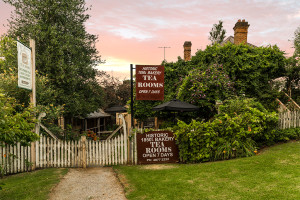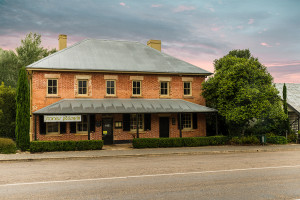To view and download maps of Berrima please Click Here
| Address: | Berrima District Historical and Family History Society Inc. |
| Description: |
Award Winning Berrima District Museum Est. 1976. Changing displays on local and family history. Open Weekends, Public School Holidays and most Public Holidays
|
| Address: | Berrima House |
| Description: |
Built 1835, this two-storey house is said to be the first stone house built in Berrima. Bushranger Ben Hall is reputed to have stayed the night on a wooden settee on the verandah in 1864
|
| Address: | Riverview |
| Description: |
At Berrima bridge nursery – this small weatherboard cottage was for a time a private girls school.
|
| Address: | McMahons Inn |
| Description: |
Built from sandstock bricks in 1834 for Byran McMahon, an ex-convict overseer for the convict gangs on the great south road, this was the first licensed Inn in Berrima.
|
| Address: | Coach and Horses Inn |
| Description: |
Originally trading as the Royal Mail Coach Inn, it was built by Michael Doyle during the 1830s.
|
| Address: | The Market Place |
| Description: |
Robert Hoddle’s original plan for Berrima revolved around the market place, once a thriving centre of activity. On the eastern side of the highway on the high ground once stood the military barracks.
|
| Address: | Victoria Inn |
| Description: |
Built in 1834, this impressive Georgian style inn was the original stopping place for Cobb and Co Coaches
|
| Address: | The First Bank |
| Description: |
This well proportioned sandstone building was the first commercial bank in the district.
|
| Address: | The Large Oak Tree |
| Description: |
This tree was planted in 1890 by Sir Henry Parkes, the Father of Federation
|
| Address: | The Post Office |
| Description: |
The present post office built in 1886 stands on the site of the old tollhouse, where tolls were collected to cross the bridge.
|
| Address: | The Surveyor General Inn |
| Description: |
Built by William Harper in 1834 and first licensed to his son James in 1835, this is the oldest continuously licensed inn in Australia
|
| Address: | Superintendent's House |
| Description: |
Built in 1898 as the residence for the Governor of Berrima Gaol, it was used as a police station in the 1930s
|
| Address: | Berrima Gaol |
| Description: |
The colonial architect Mortimer Lewis supervised construction of the Gaol over a four-year period from 1835 to 1839. Bushranger Paddy Curran was the first man hung there in 1842 and in 1834 Lucretia Dunkley became the first and only woman hung at Berrima for the axe murder of her husband. Between 1863 and 1868 the prison was enlarged and in 1866 the "silent" system was introduced; speaking to anyone was forbidden during the first nine months of a prisoner’s sentence. During WW1 the prison housed German internees and in WW2 it was used to store munitions. After extensive alterations, it reopened in 1949 as the Berrima Training Centre.
|
| Address: | Deputy Governors House |
| Description: |
Brick cottage used as Admin office for the present Governor of Berrima Gaol
|
| Address: | Bullshead Fountain |
| Description: |
Set into the northern side of the gaol wall, the overflow of water from the prison tanks gushed out of the bulls mouth into the trough below.
|
| Address: | Lambies Well |
| Description: |
Reportedly the first water supply in the village - named after assistance Surveyor John Lamb, who had charge of convict road gangs in 1830.
|
| Address: | Berrima Court House |
| Description: |
Designed by Colonial Architect Mortimer Lewis and constructed between 1835 and 1838. Quarter sessions were held from 1838 and in 1841, the first Supreme Court Assizes. Berrima Court House played a significant role in Australia’s judicial history, the very first trial by jury in the colony was held here in April 1841. The fine interior joinery is especially noteworthy, with curved cedar hewn by hand with an adze.
|
| Address: | Pair of Sandstone Cottages |
| Description: |
Adjacent to the Court House is a nearly identical pair of Georgian cottages fronting Argyle Street.
|
| Address: | Presbyterian Church |
| Description: |
Built by James Powell in 1876 as a Masonic Temple and school of arts, the building has had many uses, before being given to the church in 1930. Now privately owned and no longer open to the public.
|
| Address: | Bellvue House |
| Description: |
Dating from the early 1850s the house was named for its fine views over the valley
|
| Address: | Parsley Cottage |
| Description: |
Also known as Hopkins Cottage, this simple Georgian cottage was built c1850.
|
| Address: | Ardleigh |
| Description: |
Built in the 1840s, it was formerly the home of a market gardener
|
| Address: | Harpers Mansion |
| Description: |
This fine Georgian House was built in 1834 by James Harper, first licensee of the Surveyor General. The church bought the house in 1853 using it as a presbytery until 1898. It is now owned by the National Trust, and is on display to the public on weekends and public holidays.
|
| Address: | Old Well and Public School |
| Description: |
The well in the school grounds is reputedly convict-built. Further up the hill the original school building dates from 1869.
|
| Address: | Bramber Cottage |
| Description: |
Built in 1855, this weatherboard cottage housed the post office for some years until the present one was built in 1886.
|
| Address: | Eschalot Restaurant |
| Description: |
Built by Francis Breen as the Commercial Inn in the 1840s, it was the last of the hotels to close.
|
| Address: | The Crown Inn |
| Description: |
Built by William Taylor in the 1840s as The Crown Inn, it was later owned by William Mc Court MLA proprietor of the first newspaper in Moss Vale.
|
| Address: | The Old Bakery |
| Description: |
The bakehouse at the rear of the building now operates as a tearoom and museum. The Commercial bank operated from the house at the front during the 1880s.
|
| Address: | Holy Trinity Church |
| Description: |
Designed by Edmund Blacket in a simple Gothic Revival Style, the church is built from stone quarried directly behind it. The stained glass windows came from a church in Cornwall in England and are thought to date to the 15th Century.
|
| Address: | The Magistrate's House |
| Description: |
Built in the 1840s by James Jerome Higgins, a storekeeper and one time postmaster, the house was used by the police magistrate FR Wilshire during the 1880s.
|
| Address: | The White Horse Inn |
| Description: |
This two storey sandstone building is the largest building built in Berrima for private use, and was the home of Ben and Lucy Osborne. The house has extensive cellars and inside, the original bushranger bolts can be seen on the doors.
|
| Address: | St Francis Xavier Catholic Church |
| Description: |
Built on the site of the convict stockade. Originally known as St Scholastica’s, the foundation stone was laid by Archbishop Polding in 1849. It is one of only two churches in Australia designed by the architect Augustus Pugin, who worked on the design of the Houses of Parliament in London
|
| Address: | Old Cobb & Co Station |
| Description: |
The original Cobb and Co Station at Berrima is located behind the General Store, and can be seen from the carpark behind Mrs Oldbucks.
|


















